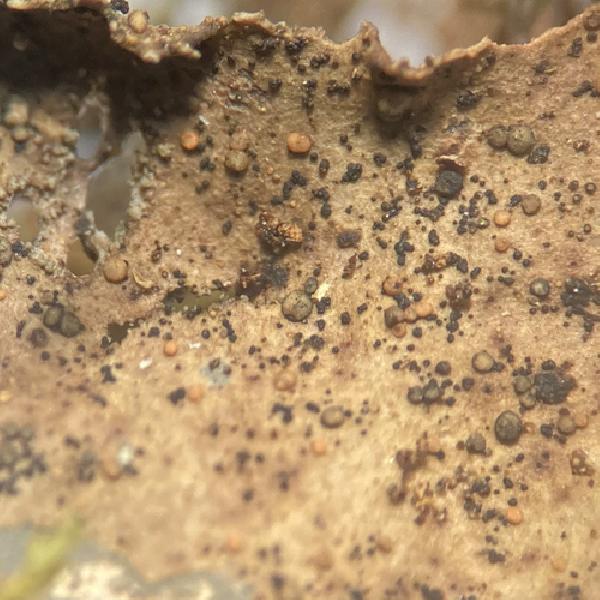Scutula miliaris (Wallr.) P. Karst.
Acta Soc. Fauna Flora Fenn., 2, 6: 149, 1885.. Basionym: Peziza miliaris Wallr. - Fl. Crypt. Germ., 2: 499, 1833.
Synonyms: Biatorina miliaris (Wallr.) Th. Fr.; Karsteniomyces peltigerae (P. Karsten) D. Hawksw.; Scutula aggregata (Bagl. & Carestia) Rehm; Scutula wallrothii var. aggregata Bagl. & Carestia
Distribution: N - Piem (Brackel 2016). C - Abr (Brackel 2016).
Description: Thallus absent, not lichenized, developing inside the thalli of Peltigera-species, without apparent damage to the host thalli. Apothecia lecideine, 0.2-0.3(-0.5) mm across, usually evenly scattered, cream-coloured to dark brown or finally black, with a flat to slightly convex disc and a usually persistent proper margin. Proper exciple 50-85 µm wide, of parallel, radiating, branched and anastomosing, strongly adglutinated hyphae, the outermost rim colourless, pale brown to dark reddish brown, the inner part colourless, greenish brown to red-brown; epithecium discontinuous, with a granular, greenish brown to greenish black pigment; hymenium colourless, 45-80 µm high, the hymenial gel hemiamyloid; paraphyses septate, very sparingly branched and anastomosing, 1.5-3(-5) µm thick, the apical cells slightly thickened, 3-6 µm wide, not capitate; hypothecium colourless to rarely pale brown, of loosely intertwined hyphae, 40-110 µm high. Asci 8-spored, with an amyloid tholus, a diffuse non-amyloid apical cushion, and an outer amyloid wall layer. Ascospores (0-)1-septate, hyaline, ellipsoid to broadly ellipsoid, (10-)11.5-14(-15) x (4-)5-6(-7) µm, thin-walled, without a perispore. Pycnidia globose, subimmersed to sessile. Microconidia hyaline, narrowly cylindrical to filiform, often slightly curved, (6-)7.5-9(-13) x 1-1.5 µm; macroconidia 0-1-septate (the septum distinct), hyaline, cylindrical, sometimes curved, (8-)13.5-19(-26) x (3-)4-5(-5.5) µm. Photobiont absent. Spot tests: K-, C-, KC-, P-, UV-. Chemistry: thallus without lichen substances; apothecia with different pigmentsNote:
Growth form: Lichenicolous fungus
Substrata: soil, terricolous mosses, and plant debris
Reproductive strategy: mainly sexual
Commonnes-rarity: (info)
Alpine belt: very rare
Subalpine belt: very rare
Oromediterranean belt: absent
Montane belt: rare
Submediterranean belt: very rare
Padanian area: absent
Humid submediterranean belt: very rare
Humid mediterranean belt: absent
Dry mediterranean belt: absent

Predictive model
Growth form: Lichenicolous fungus
Substrata: soil, terricolous mosses, and plant debris
Reproductive strategy: mainly sexual
Commonnes-rarity: (info)
Alpine belt: very rare
Subalpine belt: very rare
Oromediterranean belt: absent
Montane belt: rare
Submediterranean belt: very rare
Padanian area: absent
Humid submediterranean belt: very rare
Humid mediterranean belt: absent
Dry mediterranean belt: absent

Predictive model


